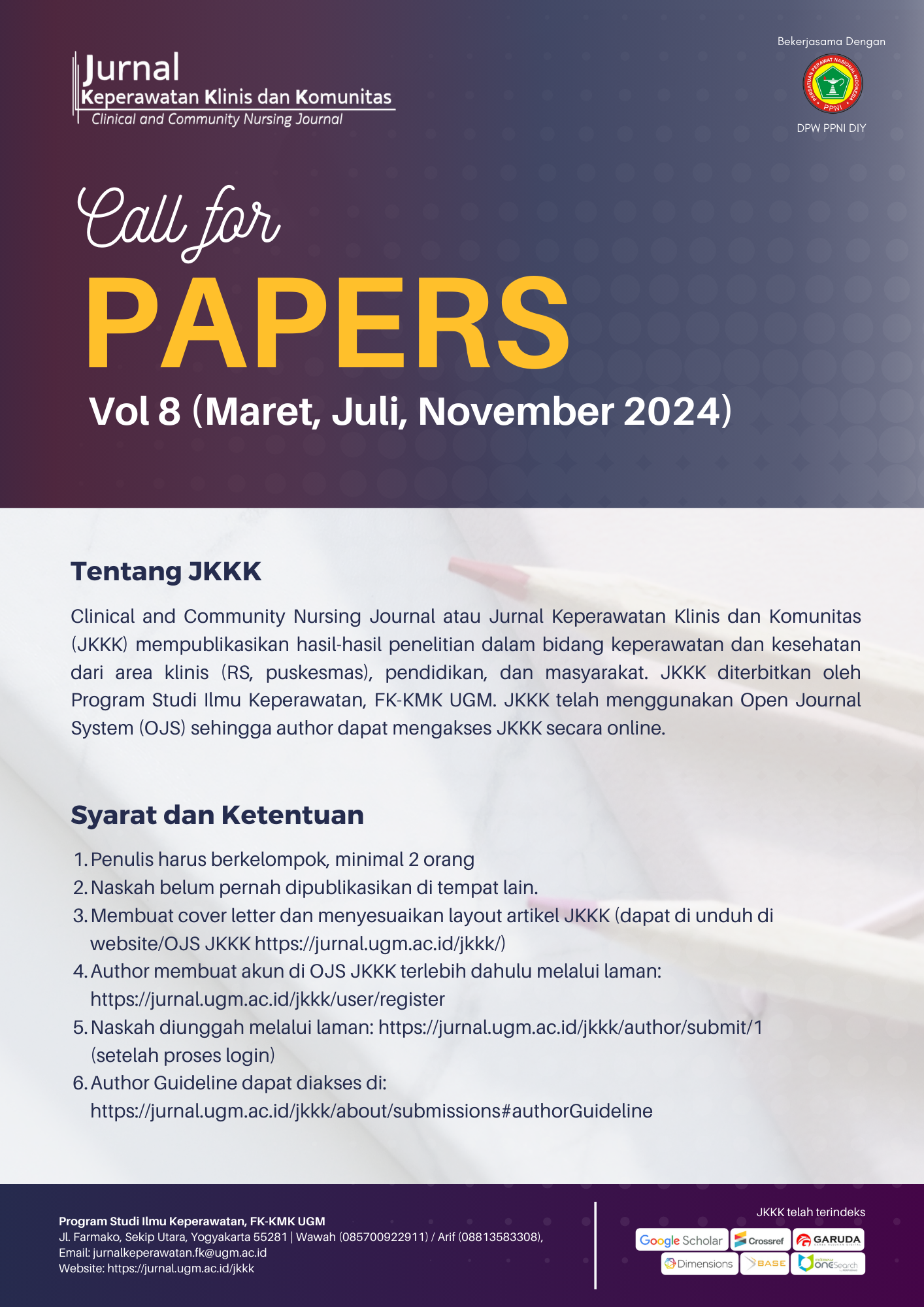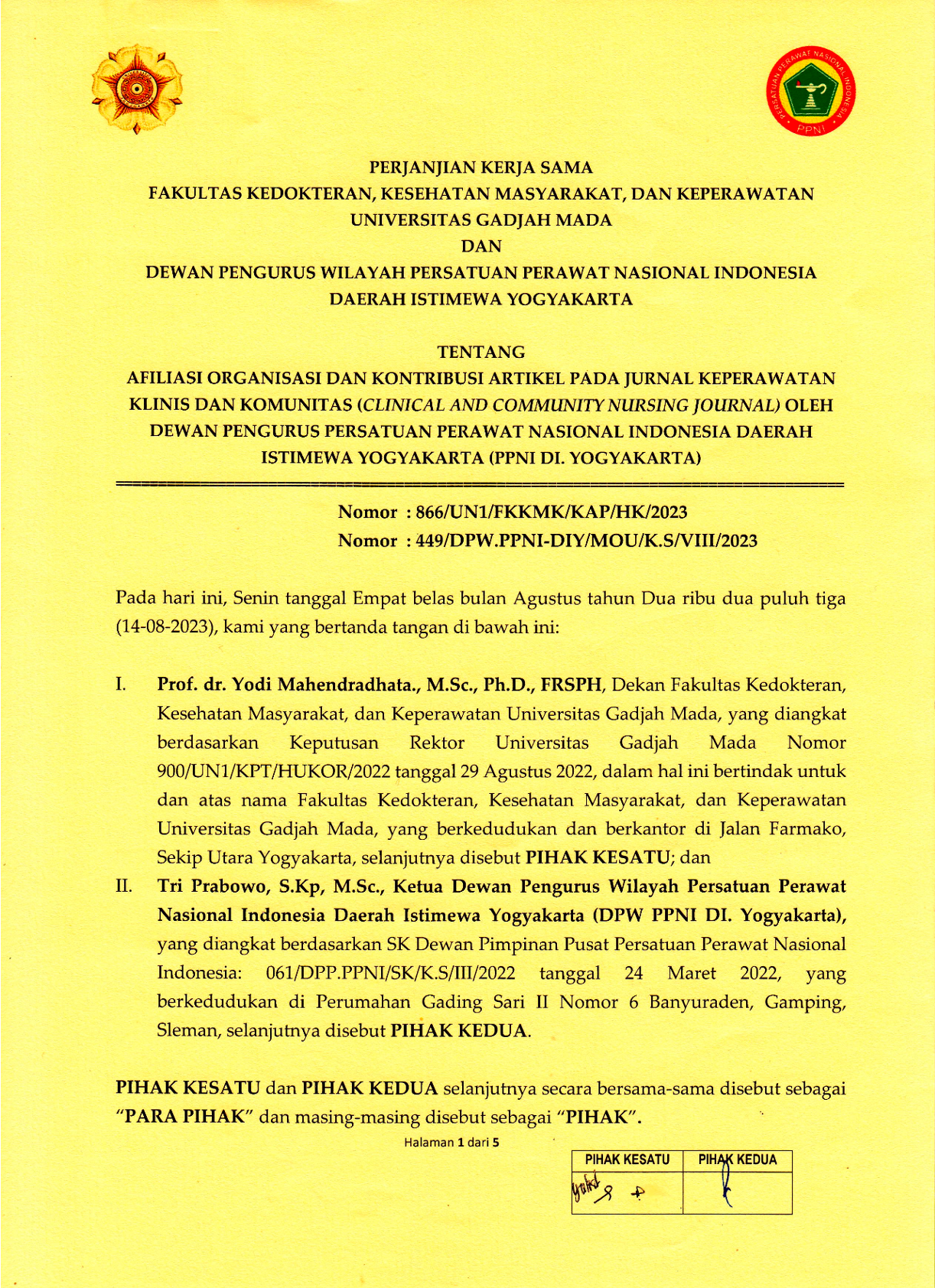Gambaran Motivasi Belajar Mahasiswa PSIK UGM terhadap Penerapan Flipped Classroom dalam Pembelajaran Keterampilan Klinik Keperawatan
Rizki Salma Fauziah(1), Totok Harjanto(2*), Kurnia Putri Yuliandari(3)
(1) Program Studi Ilmu Keperawatan, Universitas Gadjah Mada
(2) Departemen Keperawatan Dasar dan Emergensi, Fakultas Kedokteran, Kesehatan Masyarakat, dan Keperawatan Universitas Gadjah Mada
(3) Departemen Keperawatan Dasar dan Emergensi, Fakultas Kedokteran, Kesehatan Masyarakat, dan Keperawatan Universitas Gadjah Mada
(*) Corresponding Author
Abstract
Background: Flipped Classroom is a learning approach by delivering study content outside the classroom and then followed by instructor-facilitated classroom activities. There are not any research about motivation in clinical skills learning for higher education student.
Objective: To describe the student's learning motivation in the flipped classroom strategy for studying nursing clinical skills.
Method: This was quantitative descriptive research with cross-sectional design. The sample was taken using a total sampling technique which involved 101 first year students. Data was gathered with the Motivated Strategies for Learning Questionnaire (MSLQ) instrument, which had been tested for validity using Aiken's V (Content Validity Coefficient) with a value range of 0,67-1 for each item and reliability test using Cronbach alpha with a result of 0.964.
Result: There were 22 students (21,8%) who achieved high learning motivation, 53 students (52,5%) with moderate learning motivation, and 26 students (25,7%) with low learning motivation. Most students had moderate learning motivation for all six sub-scales.
Conclusion: The majority of students have moderate learning motivation in flipped classroom learning.
ABSTRAK
Latar belakang: Flipped Classroom yaitu pendekatan pembelajaran yang dilakukan dengan mengalihkan penyampaian konten pembelajaran ke luar kelas, kemudian diikuti dengan aktivitas pembelajaran dalam kelas yang difasilitasi oleh instruktur. Belum ada penelitian mengenai motivasi belajar mahasiswa dalam pembelajaran keterampilan klinik.
Tujuan: Untuk mengukur motivasi belajar mahasiswa dalam mengikuti pembelajaran keterampilan klinik keperawatan dengan metode flipped classroom.
Metode: Jenis penelitian ini yaitu cross-sectional deskriptif kuantitatif. Sampel diambil dengan teknik total sampling dan melibatkan 101 mahasiswa tahun pertama dengan instrumen Motivated Strategies for Learning Questionnaire (MSLQ) yang telah diuji validitas menggunakan Aiken’s V (Content Validity Coefficient) dengan rentang nilai setiap unit 0,67-1 dan uji reliabilitas menggunakan Cronbach alpha dengan hasil 0,964.
Hasil: Terdapat 22 mahasiswa yang memiliki motivasi belajar tinggi (21,8%), 53 mahasiswa memiliki motivasi belajar sedang (52,5%), dan 26 mahasiswa memiliki motivasi belajar rendah (25,7%). Mayoritas mahasiswa mempunyai motivasi belajar sedang pada enam sub-skala.
Simpulan: Mayoritas mahasiswa mempunyai motivasi belajar tingkat sedang dalam pembelajaran flipped classroom.
Keywords
Full Text:
PDFReferences
- Menristekdikti Nasir: Indonesia Siap Menyambut Globalisasi Pendidikan dan Revolusi Industri ke-4. 2018 [Cited Desember 2019]. Available from: https://www.brin.go.id/menristekdikti-nasir-indonesia-siap-menyambut-globalisasi-pendidikan-dan-revolusi-industri-ke-4/
- Menristekdikti: Kembangkan Perkuliahan dengan Konsep E-Learning. Badan Riset dan Inovasi Nasional; 2017 [Cited Desember 2019]. Available from: https://www.brin.go.id/menristekdikti-kembangkan-perkuliahan-dengan-konsep-e-learning/
- Inovasi Pembelajaran melalui Blended Learning dan Flipped Learning. NEWSLETTER - Pusat Inovasi dan Kajian Akademik; 2018.
- Chen F, Lui AM, Martinelli SM. A Systematic Review of The Effectiveness of Flipped Classrooms in Medical Education. Med Educ. 2017; 51(6): 585–97. https://doi.org/10.1111/medu.13272
- Betihavas V, Bridgman H, Kornhaber R, Cross M. The Evidence for “Flipping Out”: A Systematic Review of The Flipped Classroom in Nursing Education. Nurse Educ Today. 2016; 38: 15–21. https://doi.org/10.1016/j.nedt.2015.12.010
- Stayt LC. Clinical simulation: A Sine Qua Non of Nurse Education or A White Elephant? Nurse Education Today. 2012; 32(5): e23–e27. https://doi.org/10.1016/j.nedt.2011.06.003.
- Woolley NN, Jarvis Y. Situated Cognition and Cognitive Apprenticeship: A Model for Teaching and Learning Clinical Skills in A Technologically Rich and Authentic Learning Environment. Nurse Educ Today. 2007; 27(1): 73–9. https://doi.org/10.1016/j.nedt.2006.02.010
- Cook DA, Levinson AJ, Garside S, Dupras DM, Erwin PJ, Montori VM. Instructional Design Variations in Internet-Based Learning for Health Professions Education : A Systematic Review. cademic medicine : journal of the Association of American Medical Colleges. 2010; 85(5): 909–22. https://doi.org/10.1097/acm.
0b013e3181d6c319 - Holland A, Smith F, McCrossan G, Adamson E, Watt S, Penny K. Online Video in Clinical Skills Education of Oral Medication Administration for Undergraduate Student Nurses: A Mixed Methods, Prospective Cohort Study. Nurse Educ Today. 2013; 33(6): 663–70. https://doi.org/10.1016/j.nedt.2012.01.006
- Xu P, Chen Y, Nie W, Wang Y, Song T, Li H, et al. The Effectiveness of A Flipped Classroom on The Development of Chinese Nursing Students’ Skill Competence: A Systematic Review and Meta-Analysis. Nurse Educ Today. 2019; 80(April): 67–77. https://doi.org/10.1016/j.nedt.2019.06.005
- Pintrich PR, Smith DAF, Garcia T, McKeachie WJ. A Manual for The Use of The Motivated Strategies for Learning Questionnaire (MSLQ). Mediterr J Soc Sci. 1991; 6(1): 156–64. https://doi.org/10.5901/mjss.2015.v6n1p156.
- Kusurkar RA, Croiset G, Galindo-Garré F, Cate OT. Motivational Profiles of Medical Students: Association with Study Effort, Academic Performance and Exhaustion. BMC Med Educ. 2013; 13(1). https://doi.org/10.1186/1472-6920-13-87
- Azarlosa JL. Effect of Announced Quizzes on Exam Performance: II. J Instr Psychol. 2011; 38(1): 3–7.
- Keller JM. Strategies for Stimulating The Motivation to Learn. Performance & Instruction. 1987: p1–7.
- Vroom VH. Work and Motivation. Oxford, England: Wiley; 1964.
- Ryan RM, Deci EL. Self-Regulation and The Problem of Human Autonomy: Does Psychology Need Choice, Self-Determination, and Will?. J Pers. 2006; 74(6): 1557–86. https://doi.org/10.1111/j.1467-6494.2006.00420.x
- Lepper MR, Corpus JH, Iyengar SS. Intrinsic and Extrinsic Motivational Orientations in The Classroom: Age Differences and Academic Correlates. J Educ Psychol. 2005; 97(2): 184–96. http://dx.doi.org/10.1037/0022-0663.97.2.184
- Slavin RE. Educational Psychology : Theory and Practice. 12th ed. Pearson;
- Wigfield A, Cambria J. Expectancy-value Theory: Retrospective and Prospective. Vol. 16 PARTA, Advances in Motivation and Achievement. Emerald Group Publishing Limited;
- Simsek A. Learner Control. Boston, MA: Encycl Sci Learn Springer;
- Ajzen I. Attitudes, Personality, and Behaviour. Vol. №3. Open University Press; 2013.
- Bandura A. Self Efficacy The Changing of A Society. United Kingdom: Cambridge University Press; 1995.
- Schunk DH. Self-Efficacy and Academic Motivation Self-Efficacy and Academic Motivation. Educ Psychol. 2011; 26 (February 2014): 37–41. https://doi.org/10.1080/00461520.1991.9653133
- Artino AR, McCoach DB. Development and Initial Validation of The Online Learning Value and Self-Efficacy Scale. J Educ Comput Res. 2008; 38(3): 279–303.
- Awidi IT, Paynter M. The Impact of A Flipped Classroom Approach on Student Learning Experience. Comput Educ. 2019; 128 (September 2017): 269–83. https://doi.org/10.1016/j.compedu.2018.09.013
- Zientek LR, Fong CJ, Phelps, JM. (2019). Sources of Self-Efficacy of Community College Students Enrolled in Developmental Mathematics. Journal of Further and Higher Education. 43(2): 183–200. https://doi.org/10.1080/0309877X.2017.1357071.
- Belajar dan Faktor-faktor yang Memengaruhinya. Rineka Cipta; 2010.
- Akçayır G, Akçayır M. The Flipped Classroom: A Review of Its Advantages and Challenges. Comput Educ. 2018; 126(January): 334–45. https://doi.org/10.1016/j.compedu.2018.07.021
- Klimova BF. Self-Reflection in The Course Evaluation. Procedia - Soc Behav Sci. 2014; 141: 119–23. https://doi.org/10.1016/j.sbspro.2014.05.022
Article Metrics
Refbacks
- There are currently no refbacks.
Copyright (c) 2022 Rizki Salma Fauziah, Totok Harjanto, Kurnia Putri Yuliandari

Jurnal Keperawatan Klinis dan Komunitas (Clinical and Community Nursing Journal)
collaborates with DPW PPNI DIY
![]()
Jurnal Keperawatan Klinis dan Komunitas (Clinical and Community Nursing Journal) is licensed under a Creative Commons Attribution-ShareAlike 4.0 International License.




